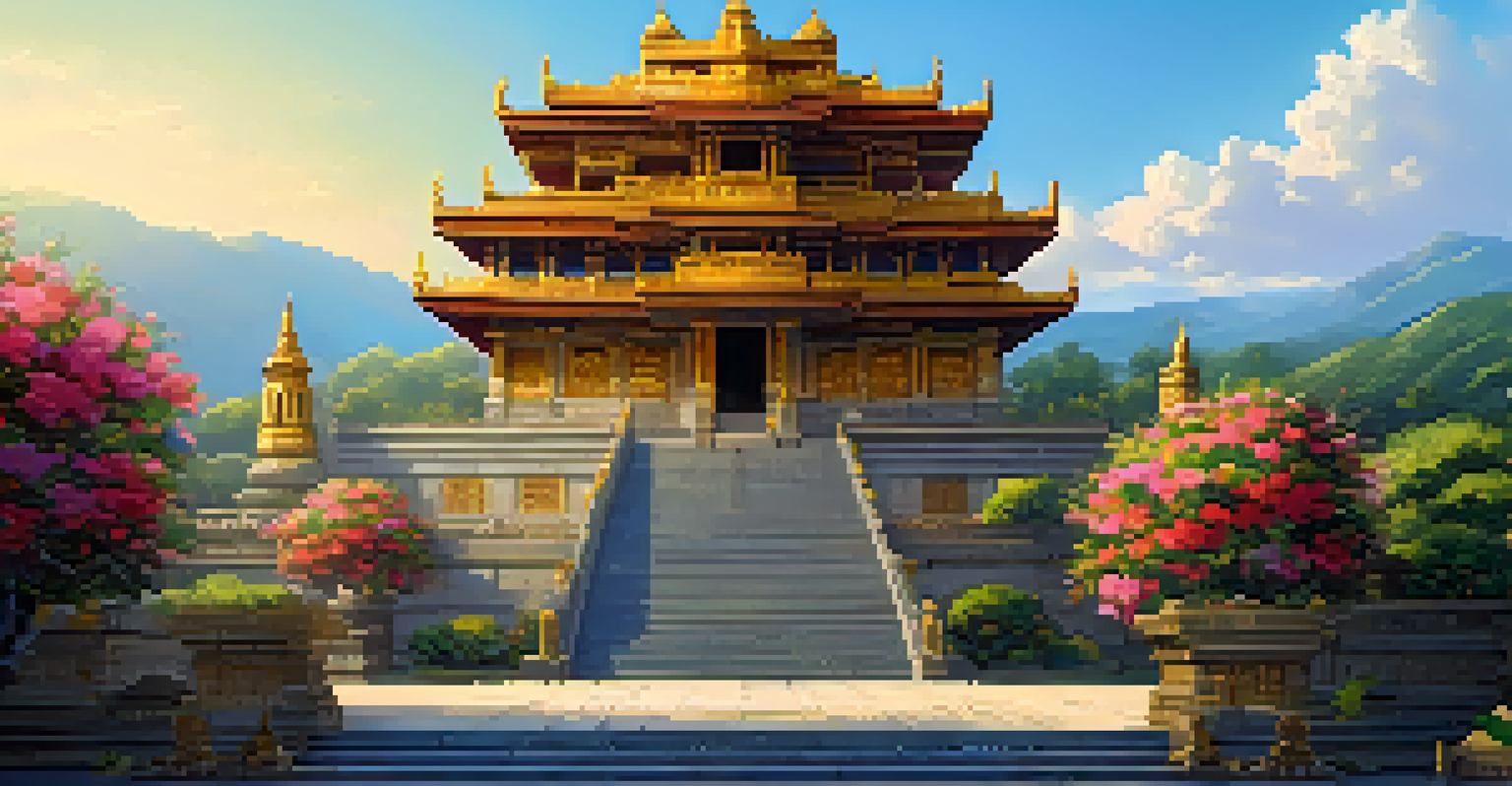The Origins of the Inca: Legends Behind a Great Civilization

The Mysterious Birth of the Inca Empire
The Inca Empire, one of the most remarkable civilizations in history, has its roots steeped in mystery and legend. According to lore, the Incas were descended from the sun god, Inti, who sent his children, Manco Cápac and Mama Ocllo, to establish a great civilization. They emerged from the shores of Lake Titicaca, a place considered sacred, symbolizing the union of the earth and sky.
The greatest legacy of a civilization is not its buildings but the stories it leaves behind.
This myth not only emphasizes the divine origins of the Incas but also highlights their deep connection to nature. The couple was tasked with finding a suitable place to settle, which they did upon discovering the fertile valley of Cusco. This blend of divine guidance and earthly determination showcases the Incas' belief in a harmonious relationship with their environment.
As Manco Cápac and Mama Ocllo began to build their society, they laid the foundation for what would become the heart of the Inca Empire. Their legendary journey reflects the themes of perseverance and destiny, which resonate deeply with the Inca people and their descendants to this day.
The Role of Inti: The Sun God in Inca Culture
Inti, the sun god, played a pivotal role in Inca culture and society. Revered as the source of life and light, Inti was not just a deity but a symbol of prosperity and agriculture. Festivals dedicated to him, like Inti Raymi, celebrated the sun’s return and ensured a good harvest, showcasing the Incas' reliance on seasonal cycles.

The Incas believed that their rulers, known as Sapa Inca, were direct descendants of Inti, which solidified their authority and divinity. This connection reinforced social hierarchies and justified the Sapa Inca's power over the vast empire. Thus, Inti was more than a god; he was a crucial figure in maintaining societal order.
Divine Origins of the Incas
The Incas believed they were descended from the sun god Inti, highlighting their deep connection to nature and divine guidance in establishing their civilization.
Moreover, the worship of Inti led to impressive architectural feats, including temples and observatories aligned with celestial events. This reverence for the sun illustrates how deeply intertwined spirituality and daily life were in Inca civilization, shaping their identity and existence.
Mama Quilla: The Moon Goddess and Her Influence
While Inti was celebrated as the sun god, Mama Quilla, the moon goddess, held equal significance in Inca mythology. She was revered for her influence over women, marriage, and fertility, making her an essential figure in daily life. The phases of the moon were closely observed and often linked to agricultural practices, emphasizing the balance of both deities.
In mythology, we find the reflection of humanity's deepest values and hopes.
Inca women would pray to Mama Quilla for guidance and blessings in their roles as mothers and caretakers. Her representation in various festivals and rituals highlighted the importance of femininity in their society. This duality of divine figures allowed the Incas to find harmony in their beliefs.
The moon goddess also played a role in the Inca calendar, with her cycles informing various agricultural and ceremonial events. This connection shows how the Incas integrated their natural surroundings into their spiritual practices, reflecting their respect for both the sun and the moon in their quest for balance.
The Legend of the Ayar Brothers: Founders of the Inca
The story of the Ayar Brothers is a captivating tale that speaks to the founding of the Inca civilization. According to legend, the brothers—Ayar Manco, Ayar Cachi, Ayar Uchu, and Ayar Auca—emerged from a cave, sent by their father, the sun god. Each brother represented different strengths and attributes essential for establishing their society.
As this legend unfolds, Ayar Manco becomes the leader, guiding the brothers in their quest for a homeland. However, the journey was not without challenges, as rivalry and conflict arose between them. Ultimately, Ayar Cachi was banished, symbolizing the struggles inherent in leadership and the establishment of a new society.
Influence of Inti and Mama Quilla
Inti, the sun god, and Mama Quilla, the moon goddess, played crucial roles in Inca culture, shaping agricultural practices and societal norms through their worship.
This tale encapsulates themes of unity, conflict, and the importance of strong leadership in the formation of the Inca Empire. The Ayar Brothers' story serves as an allegory for the challenges faced by any civilization in its quest for greatness, making it a timeless narrative for the Inca people.
Viracocha: The Creator God and His Legacy
Viracocha, the creator god, occupies a unique place in Inca mythology, embodying the essence of creation and civilization. Considered the father of all things, he was believed to have formed the earth, stars, and humans. This god’s narrative emphasizes the Incas' view of the world as intricately designed and purposeful.
According to legend, Viracocha traveled the earth, teaching humanity essential skills like agriculture and weaving. His journey symbolizes the imparting of knowledge and culture, which were vital for the development of the Inca civilization. This notion of a creator sharing wisdom resonates with the value placed on education and progress within their society.
Viracocha’s legacy can be seen in the architectural marvels and societal advancements of the Inca Empire. His influence is a reminder of the importance of innovation and creativity, reinforcing the idea that a civilization's growth is often rooted in its myths and the values they espouse.
The Sacred Geography of the Inca Empire
The geography of the Inca Empire was not only vast but also sacred, shaping their worldview and religious practices. The Incas believed that the mountains, rivers, and valleys were imbued with spiritual significance, often associated with various deities. This reverence for nature fostered a deep connection to the land, influencing their agricultural and architectural choices.
For instance, the Andes mountains were seen as the home of powerful spirits, and the Incas constructed impressive structures like Machu Picchu in harmony with their surroundings. This integration of nature and architecture reflects a profound respect for the environment, showcasing how geography played a crucial role in their cultural identity.
Sacred Geography and Spirituality
The geography of the Inca Empire was considered sacred, deeply influencing their religious practices and architectural choices, reflecting a harmonious relationship with nature.
Moreover, sacred sites were often aligned with celestial events, further deepening the Incas' connection to the cosmos. This relationship not only guided their daily lives but also reinforced their beliefs, demonstrating how geography was interwoven with their spiritual and cultural practices.
The Enduring Legacy of Inca Legends
The legends of the Inca civilization continue to resonate today, providing insight into their values and beliefs. These stories of divine origin, powerful deities, and heroic figures shape the identity of modern-day Peruvians and the broader Andean community. They serve as a reminder of the resilience and ingenuity of a civilization that once thrived in the rugged Andes.
Through festivals, rituals, and cultural expressions, the legacy of the Incas remains alive. The tales of Inti, Mama Quilla, and the Ayar Brothers are not merely historical accounts; they embody the spirit of the Inca people and their connection to the land. This cultural continuity underscores the importance of preserving these narratives for future generations.

Ultimately, the legends of the Inca civilization are a powerful testament to human creativity and the enduring quest for understanding our place in the world. They inspire us to appreciate the richness of our histories while reminding us of the values that unite us across time and space.